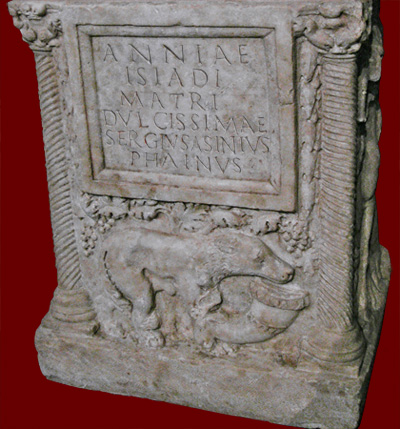 Marble altar, 2nd century CE (side view)
Marble altar, 2nd century CE (side view)
Annia Isias was a freedwoman, although her status as liberta is not recorded in her inscription (see freed nomenclature). She was once a slave, Isias by name, of the gens Annia, an ancient plebeian family which produced three generations of empresses in the 2nd century CE: Faustina Maior (wife of Antoninus Pius), Faustina Minor (wife of Marcus Aurelius), Lucilla (wife of Lucius Verus). She may have formed a relationship in this imperial familia with her fellow slave, Polychrysus, with whom she produced two children. Her funerary altar was dedicated by her son, Sergius Asinius Phainus, a freedman of the plebeian gens Asinia, who was born into slavery and was transferred to a new master. Phainus also honored his father Polychrysus (parenti dulcissimo), the emperor's freedman for military supplies, with an urn (see CIL 6.8540) and erected a marble tombstone (see CIL 6.11792) for his sister (sorori optimae), Cornelia Thallusa, freed by a member of the gens Cornelia. His acts of filial piety toward his natal family reveal a family connection made invisible by the names they received when emancipated by their different masters and testify to the possibility of preserving emotional ties in the face of separations frequently endured by slaves. Phainus, seemingly prosperous and successful, survived them and was buried by a friend (see CIL 6. 11790, perhaps also 11791). Isias' altar is two feet high and elaborately carved on three sides, doubtless at some expense. The front face of the altar is framed by two spirally fluted columns, a feature of early imperial decorative art; a grapevine, suspended from each dolphin capital, wraps around the inscription frame. Below is a relief of a pantheress beside a goat's head rhyton (a libation cup), perhaps in reference to the funeral banquet that commemorates the dead. The iconography evokes agricultural fertility and pastoral peace, touchstones of traditional Roman values. The grapevine is a conventional funerary motif associated with Dionysus, as is the panther, a pair of which often draws the god's chariot. While panthers are popular in Roman art of the period, the choice of a panther with marked maternal features gives visual emphasis to the simple inscription, articulating the gender of the deceased and her relation to Phainus. On either side of the altar sits a large griffin beside a quiver and a laurel tree, evocative of the god Apollo. Thus Isias is immortalized with a rich vocabulary of mythological and cultural allusions that commemorate a well-loved mother.
Click on the underlined words for translation aids and commentary, which will appear in a small window. Click on the icon link
![]() to the right of the line for related images.
to the right of the line for related images.